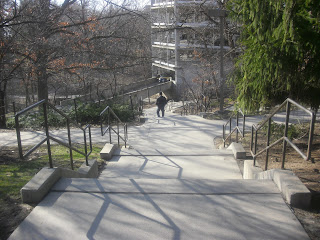1. Herzog's purpose in revealing Treadwell's death early is to change the story. New questions are asked when you learn that Tim is killed by the very animals he loves so much. It almost makes his love of bears more heroic. Later in the story we learn the circumstances behind Tim's death. Tim didn't like the bear that mauled him. He was also supposed to leave the month before but didn't because there was problems with his ticket. So, after a fight with his girlfriend, they stayed. I think Herzog keeps this information until the end of the film, because it paints a more tragic picture of his death. It makes it seem like Tim wasn't supposed to die. It gives the viewer more compassion towards Tim.
2. When Herzog uses I believe, He brings his thoughts and opinions into the film. This affects his credibility because he presents the film from his own point of view and chooses material to support his own beliefs rather that presenting all evidence. Herzog enters his own film as a character because he's trying to make sense of what happened. We see in the scene where he presents the audiotape to Amy that he seems to have a personal connection to Tim's death. I think Herzog is just as confused by Tim's life as everyone else is. He's trying to reconcile Tim's passion for the bears and what Time said he was doing with what was actually taking place.
3. Herzog depicts Timothy Treadwell as a troubled, mentally unstable person. He shows clips of Tim's that no one was supposed to see. He shows footage of Tim's private thoughts. In these clips, Tim's personal demons are on display. We learn that he longs for companionship and also that he had a drinking problem until he discovered the bears. In one scene Tim is using profanity against the park rangers. He rages, swears, and says awful things about them. Then Tim turns right around and gives a pleasant conclusion to his summer with the bears. Herzog seems to say with this footage how unstable Tim really was. His friends and family depict Tim as a passionate, loving person who was very much unstable. The instability is consistent with how Herzog depicts him.
4. I think Treadwell was trying to find a purpose and escape reality. He had a life filled with highs and lows and many disappointments. I think Tim was looking for a way to escape. His life with the bears gave him a purpose. Tim ignored the reality of what he was actually doing in order to preserve this life that gave him love, and the feeling that he was helping. He says multiple times in his tapes that he feels like what he's doing is right. He also says he's the only one helping the bears when, in reality, they are protected on a reservation. He ignores the reservations rules to keep 10 feet away from the bears and camps in areas in the park for longer than allowed. We learn that these practices can habituate the bears to human presence and ultimately harm the bears. Herzog depicts Tim as accomplishing nothing but harming the bears he sought to protect. I think Herzog's purpose in making the film was to show the negative side of Tim Treadwell's life.
5. The film is arguing that there is a distinct boundary between the human world and nature. We can never truly be part of the nature because wild nature has very different rules than the human world. Only twice in the film, Tim confronts death in wild nature. One time is a bear cub that was eaten and once is a fox eaten by wolves. Tim mourns these deaths as if his own friends had died. He ignores the fact that in nature, predation is normal. Tim treats death as an isolated occurrence when it’s the rule.
6. I don't think Tim has a sentimentalized view that the universe is in harmony and balance. I think Treadwell did have a sentimentalized view of nature as a perfect world that the human world wasn't. The human world was filled with disappointment for Treadwell. He tried to make nature everything the human world wasn't for him. Herzog included the statement, "I believe the common denominator of the universe is not harmony, but chaos, hostility, and murder because from Herzog's point of view, Tim's life was filled with chaos, hostility and murder. He was killed by the animals he was most passionate about. This supports Herzog's claim that nature is wild and fundamentally different than the human world.
7. Herzog didn't release the audio of Tim and Amy's death out of respect. Instead, Herzog films Tim's old friend listening to the tape. We see the friend's face contort in pain and see her react to the audio. This is almost more shocking to the audience. We see how terrible it is on another’s face and are left to imagine exactly how horrible it is. In depicting the details of Timothy and Amy's death, Herzog risks disrespecting Timothy and Amy. Their death was gruesome and very private.
8. Timothy Treadwell's background brings more doubts into my mind about the stability of his mental state. Herzog depicts Tim's upbringing and parents as a normal All American boy. I was not surprised by his childhood, but was very surprised by his history. I was especially surprised when I learned that Tim had tried to make it in Hollywood and changed his name and identity when he lost a part. I think Herzog waited to share this so the viewer would have an open mind to Tim's work with the bears.





























